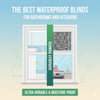Vertical vs. Panel Track Blinds: Which is Better for Wide Windows and Sliding Doors?
- by Mariam Labadze
 Quick Answer
Quick Answer
Vertical options feature individual slats that hang vertically and rotate for light control, ideal for sliding doors and windows where you need frequent access and precise light adjustment. Panel track systems use large fabric panels that glide horizontally on tracks, creating a sleek, modern aesthetic perfect for expansive windows and contemporary spaces. Vertical styles offer superior functionality for doors requiring regular access, cost less, and suit traditional interiors. Panel tracks deliver minimalist elegance, work brilliantly as room dividers, and complement modern design schemes. Your choice depends on whether you prioritize practical daily operation or contemporary architectural impact.
[toc]
Key Differences at a Glance
-
Operation style – Vertical slats rotate and stack to one side; panel tracks slide horizontally across the opening
-
Aesthetic appeal – Vertical suits traditional and transitional spaces; panel tracks deliver contemporary, gallery-like elegance
-
Door functionality – Vertical styles excel for frequently accessed sliding doors; panel tracks better suit occasional-use openings
-
Light control precision – Slats tilt for adjustable light filtering; panel tracks offer open or closed positions with limited mid-range control
-
Installation complexity – Vertical systems install more simply; panel tracks require precise tracking mechanisms
-
Cost comparison – Vertical options typically cost 30-50% less than panel track systems
-
Room divider potential – Panel tracks function excellently as space separators; vertical styles less effective for this purpose
Understanding Vertical Systems
This established solution has served UK homes for decades, particularly for sliding patio doors and wide windows. The system comprises individual slats—typically 89mm or 127mm wide—suspended from a head rail that allows each piece to rotate 180 degrees for light control and stack completely to one side for full access.
The vertical orientation prevents dust accumulation that plagues horizontal alternatives, making them exceptionally low-maintenance. A quick wipe with a damp cloth keeps slats looking fresh, whilst the vertical hanging ensures gravity naturally maintains alignment without sagging issues.
Modern versions have evolved far beyond the basic vinyl slats associated with 1980s offices. Today's options include fabric, faux wood, and textured materials in sophisticated colors and patterns that complement contemporary interiors whilst retaining the practical benefits that made this style popular initially.
The rotating slat mechanism provides exceptional light control flexibility. Angle them to filter daylight whilst maintaining privacy, or rotate perpendicular to the window for maximum light admission. This adjustability throughout the day means you needn't fully open or close the treatment to manage changing light conditions.
When opened, slats stack compactly, consuming minimal space beside the door or window. This efficiency matters in rooms where furniture placement or traffic flow makes bulky window treatments impractical. The slats neatly gather to one side—or split to both sides—maximizing unobstructed access.
Exploring Panel Track Systems
Panel track systems represent a more recent innovation that reimagines window covering design with architectural sophistication. Large fabric panels—typically 60cm to 120cm wide—hang from multi-channel tracking systems, sliding horizontally across openings like Japanese shoji screens.
The minimalist aesthetic creates clean, uncluttered lines that align perfectly with contemporary design principles. These function as architectural elements rather than mere window dressings, contributing to overall room design in ways traditional treatments cannot achieve.
Each panel overlaps slightly with adjacent ones when closed, creating continuous coverage without gaps. The substantial fabric sections—often floor-to-ceiling—make bold design statements whilst providing excellent light blocking and privacy when required.
This approach excels in modern open-plan homes where expansive glazing blurs boundaries between interior and exterior spaces. The sleek profiles complement architectural glazing systems, floor-to-ceiling windows, and minimalist interiors where visual simplicity matters tremendously.
Beyond window coverage, panel tracks function brilliantly as room dividers, separating open-plan spaces without permanent walls. Slide panels to create temporary privacy for home offices, separate sleeping areas in studio flats, or define dining zones in great rooms—then retract them completely when open flow suits activities better.
Functionality for Sliding Doors
Sliding patio doors present specific challenges requiring frequent access, weather resistance, and smooth operation withstanding thousands of annual openings. Vertical systems excel in this application because their design specifically addresses these demands.
The draw mechanism allows quick one-handed operation—pull the chain or wand to stack slats instantly, providing immediate door access. This convenience matters when carrying groceries, supervising children playing outside, or moving between indoor and outdoor spaces throughout the day.
Slats clear the door threshold completely when stacked, eliminating tripping hazards or obstructions that might catch feet or furniture during passage. This safety consideration proves particularly valuable in homes with elderly residents, young children, or anyone with mobility challenges.
Panel track systems on sliding doors work acceptably but require more deliberate operation. You must slide multiple panels sequentially to fully clear the opening, taking more time and effort than a single pull operation. For doors used multiple times daily, this difference becomes noticeable.
However, panel tracks on sliding doors create stunning visual impact in contemporary homes where aesthetic considerations outweigh convenience factors. If your patio door primarily serves as a window with occasional access, this approach delivers superior style without significant functional compromise.
Performance on Wide Windows
Large picture windows and expansive wall glazing showcase both systems effectively, though with different strengths. Vertical blind options on wide windows provide excellent light control flexibility through slat rotation, managing changing daylight throughout the day without opening or closing the entire treatment.
The vertical lines create visual height, making rooms feel taller—a valuable trick in spaces with standard ceiling heights. This vertical emphasis complements modern architecture whilst counterbalancing horizontal lines from furniture and architectural elements.
Panel track systems on wide windows deliver gallery-like elegance impossible to achieve with traditional treatments. The large fabric panels function almost like moveable artwork, particularly when featuring bold patterns, rich textures, or striking colors that make design statements.
The horizontal sliding motion aligns naturally with the horizontal expanse of wide windows, creating visual harmony. This directional consistency produces cohesive, intentional design that feels architecturally integrated rather than merely applied.
For windows spanning entire walls—common in modern extensions and open-plan living areas—panel tracks prevent the visual clutter that numerous slats might create. Three or four large panels appear more sophisticated than dozens of individual pieces covering the same area.
Aesthetic Considerations and Interior Styles
Vertical treatments suit traditional, transitional, and casual interior styles comfortably. They integrate easily into existing decor without demanding attention, functioning as practical solutions rather than design focal points. This versatility makes them safe choices for rental properties or homes undergoing gradual style evolution.
Modern versions in fabric finishes or contemporary colors elevate beyond basic functionality, though they rarely achieve the design impact of more architectural window treatments. They enhance spaces without transforming them, providing competent solutions that satisfy practical requirements.
Panel track systems demand contemporary or minimalist settings where their bold aesthetic receives appropriate context. Installing them in traditionally decorated rooms creates jarring style conflicts that undermine both the tracks and existing decor.
The clean lines and substantial presence of panel tracks complement modern furniture, open spaces, and neutral color schemes that define contemporary design. They work beautifully alongside exposed concrete, steel-framed windows, and minimalist kitchens where every element contributes to cohesive modern aesthetics.
Color and fabric choices dramatically affect both systems' design impact. Neutral tones in vertical styles disappear into backgrounds, whilst bold colors make statements. Panel tracks featuring striking patterns or luxurious fabrics become room focal points, demanding careful coordination with overall design schemes.
Light Control and Privacy Options
Vertical systems offer superior light control flexibility through their rotating slat mechanism. Angle them to admit soft, filtered light whilst blocking direct glare—perfect for television viewing or computer work. Rotate slats perpendicular to windows for maximum brightness without fully opening the treatment.
This adjustability means they rarely need full operation for light management, extending mechanism life and maintaining consistent appearance. You adjust light throughout the day through rotation rather than constantly opening and closing the entire system.
Panel tracks operate in essentially binary fashion—panels either block light or don't. Partial opening creates zones of light and shadow rather than evenly filtered illumination across the entire opening. This limitation suits spaces where dramatic light transitions enhance rather than hinder activities.
Layered panel track systems overcome this limitation by incorporating alternating sheer and opaque panels. Arrange them to create combinations of filtered light and privacy, though this configuration increases cost substantially and requires more complex track systems.
Privacy considerations favor vertical options for ground-floor spaces or properties overlooking public areas. The ability to angle slats provides privacy whilst admitting daylight—impossible with panel tracks that must remain closed for privacy, thereby sacrificing natural light entirely.
Installation and Maintenance Requirements
Vertical system installation requires mounting a head rail above the opening—relatively straightforward for competent DIYers with basic tools. These systems tolerate minor measurement errors more forgivingly than some alternatives, and individual slat replacement addresses damage without replacing entire systems.
Regular maintenance involves occasional slat wiping and infrequent chain or mechanism lubrication. Their simplicity means fewer components that might fail, and their established presence in the market ensures readily available replacement parts for repairs.
Panel track systems demand more precise installation. The multi-channel tracks must mount perfectly level to ensure smooth panel operation, and accurate measurements prove critical for proper function. Professional installation often justifies its cost by ensuring optimal performance from the outset.
Maintenance remains minimal once installed—occasional track vacuuming removes dust, and panels might require periodic professional cleaning depending on fabric selection. The larger fabric panels clean less frequently than individual slats but may need more involved cleaning processes when necessary.
Cost Analysis
Vertical options represent economical solutions for large openings. A standard patio door might cost £150-£300 for quality treatments including installation, making them accessible for most budgets. Wide windows scale proportionally, typically remaining affordable even for expansive glazing.
Panel track systems cost significantly more—often £400-£800 for comparable patio door coverage, with prices escalating quickly for wide windows or premium fabrics. The substantial investment reflects more complex hardware, larger fabric requirements, and typically professional installation.
Long-term value considerations slightly favor vertical systems due to simpler mechanisms with fewer potential failure points. However, both deliver years of reliable service when quality products receive proper installation and reasonable care.
Budget-conscious homeowners often choose vertical solutions for practical spaces like family rooms and kitchens whilst reserving panel tracks for showcase areas like master suites or formal living rooms where design impact justifies premium investment.
Making Your Decision
Assess your priorities honestly. If you need practical, affordable window treatments for frequently used sliding doors in traditionally decorated spaces, vertical options deliver excellent value and functionality. They solve problems efficiently without demanding attention or premium budgets.
If you're creating contemporary spaces where every element contributes to cohesive modern design, and your openings serve more as architectural features than daily-use doors, panel tracks offer sophistication that elevates entire rooms. The investment reflects design ambition rather than mere window covering.
Consider hybrid approaches for homes with multiple large openings. Install vertical systems on high-traffic patio doors requiring frequent access whilst using panel tracks on picture windows or occasional-use doors where aesthetic impact outweighs operational convenience.
At 1 Click Blinds, quality window covering solutions provide performance tailored to your specific requirements. Understanding how you use your spaces, what aesthetic you're creating, and which practical considerations matter most guides you toward treatments that genuinely enhance your home.







